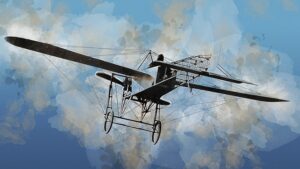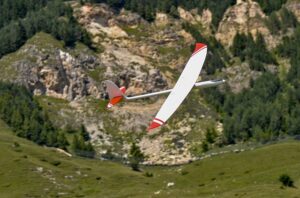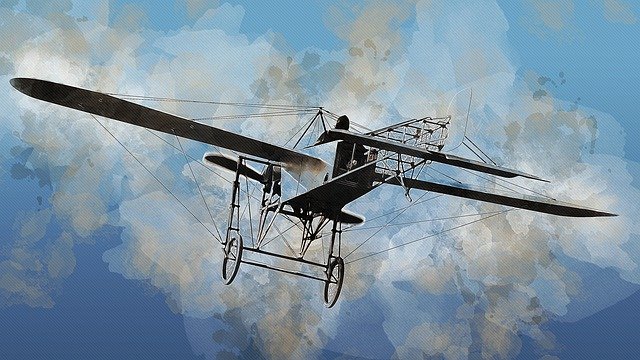
The history of the airplane is a long and interesting one.
It all started with the Wright brothers, who are considered to be the inventors of the airplane.
However, there were many other people who played a role in the development of the airplane.
The first successful powered flight was made by the Wright brothers on December 17, 1903. However, they were not the only ones to develop the airplane.
Other events and people led up to that momentous occasion, and others were involved in early flight after that point.
The Invention of the Airplane
It all started when in 1799, Sir George Cayley came up with an idea for an airplane.
He described the idea of a fixed-wing aircraft with movable wings for control. However, he never actually built one to test it out.
Next came Otto Lilienthal in the 19th century who built and tested many gliders. He was the first person to make controlled flights with a glider.
In the early 1900s, many people were working on airplanes. The Wright brothers were just one of many teams trying to build a successful aircraft.
There were also people like Samuel Langley and Clément Ader who were trying to create an airplane.
However, the Wright brothers were the first to actually achieve powered flight. They did this on December 17, 1903, with their aircraft called the Wright Flyer.
After that point, many other people started working on airplanes and developing new technologies.
The objective of the Wright Brothers experiments in gliders and kites?

The Wright brothers were trying to figure out how airplanes could fly and stay in the air for a long time.
They used gliders and kites as tools to help them do this. For example, they tested different wing shapes to figure out how the wings could generate lift.
They also tested different wing sizes to see how they affected flight.
The Wright brothers were trying to learn more about flight so that they could create a powered aircraft that would actually fly for a long time.
Cassie, Tia Norell(c), 2014, How Was The First Airplane Invented?, San Diego State University Library
The timeline of the progression of flight
October 4, 2001: Scaled Composite’s SpaceShipOne completed its first supersonic, rocket-powered flight. This was successful because it met all of the requirements for manned spaceflight set by the Ansari X Prize.
July 20, 1969: The Apollo 11 mission was launched, and on July 20 Neil Armstrong became the first human to have ever walked on the moon.
1903: The Wright brothers make the first successful powered flight.
1807: Sir George Cayley is the first to fully understand the concepts of lift and streamlining.
1783: Jean-François Pilâtre de Rozier and François Laurent d’Arlandes fly a hot air balloon in Paris, France.
1678: Francesco Lana de Terzi’s proposed flying machine was published with a design for a lighter-than-air airship.
1648: Jesuit missionary Brother Giambattista Canaveri attempts to fly off the roof of St. Mark’s Basilica in Venice on a device with rotating oars and wings.
391 BC: According to legend, Daedalus successfully flew using artificial wings that his son, Icarus, did not have on. When flying too close to the sun, the wax holding the wings together melted, and Icarus fell into the sea and drowned.
It looks like flight was being researched all over the world for centuries before the Wright brothers were able to successfully create an airplane that could actually take flight!
The Wright brothers were not the only ones who helped to create the airplane, many other important people and events have taken place in order to make flying what it is today.
We owe a lot to these brave and ingenious individuals!
- See also: How was the refrigerator invented
- See also: How was electricity invented
The Development of the Airplane
There were many challenges involved in the development of the airplane. One of the biggest challenges was creating an aircraft that could lift off the ground and fly.
Another big challenge was designing an aircraft that was stable and controllable in the air.
The Wright brothers were able to do this with their Wright Flyer, but it took a lot of experimentation and testing to get there.
In addition, the early airplanes were very dangerous to fly.
There were a lot of accidents and fatalities during the early years of flying. However, people continued to work on developing new technologies and making airplanes safer.
Nowadays, airplanes are much safer to fly and there are many more regulations in place.
This is due to the hard work of all the people who have worked on developing airplanes and taking them to new heights.
Conclusion
The timeline shows that people were researching flight for centuries before the Wright brothers built their airplanes.
While there are many people who deserve credit for developing the first successful airplane, some of those that deserve recognition include:
- Leonardo da Vinci(1452 – 1519)
- Sir George Cayley (1773 – 1857)
- Richard Pearse (1877 – 1953)
- John J. Montgomery (1858 – 1931)
It was not an easy task to develop the first airplane!
The Wright brothers were very intelligent inventors and their hard work paid off as they successfully flew their plane into the sky!
We all owe them a lot for helping to create what we know today as human flight.



